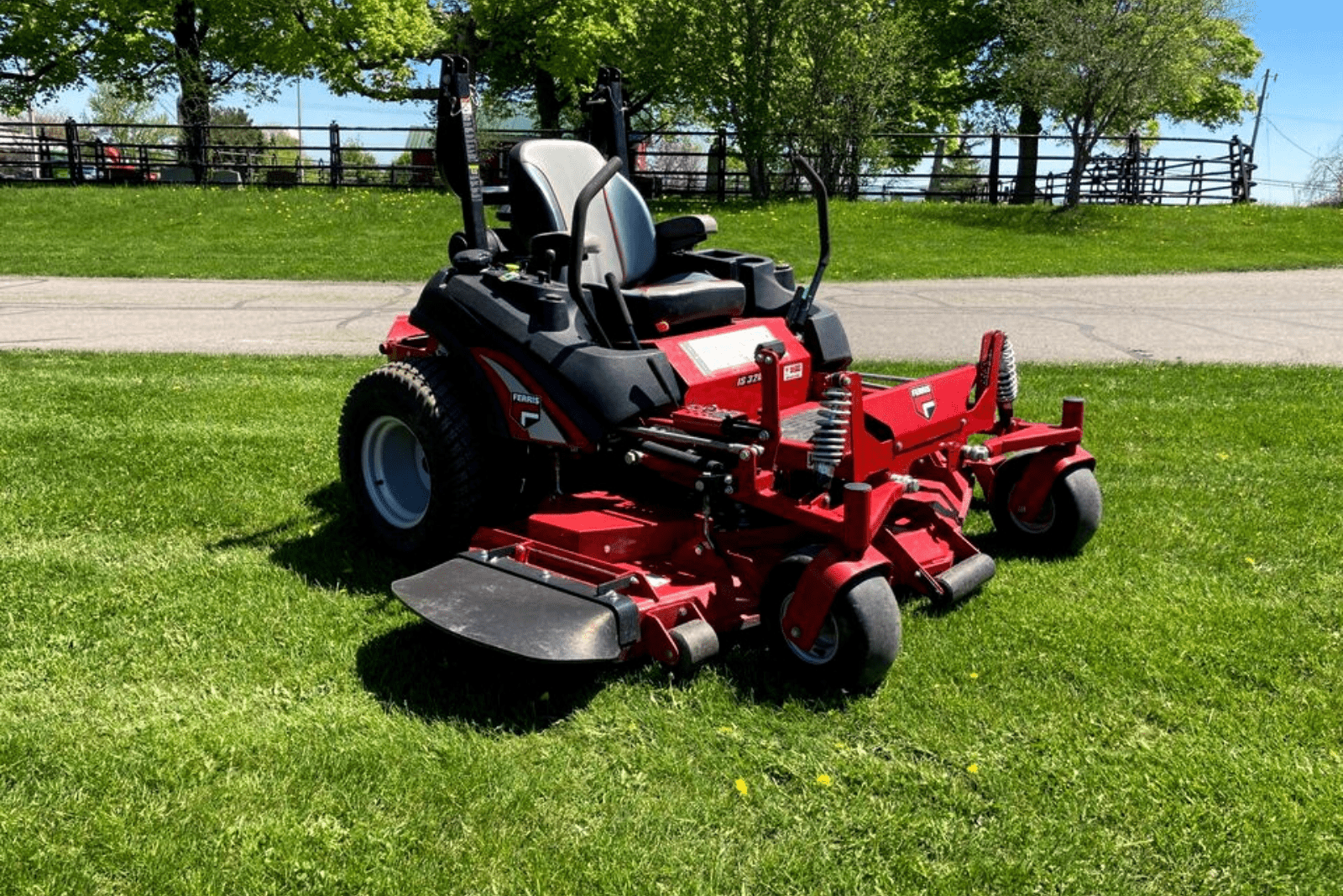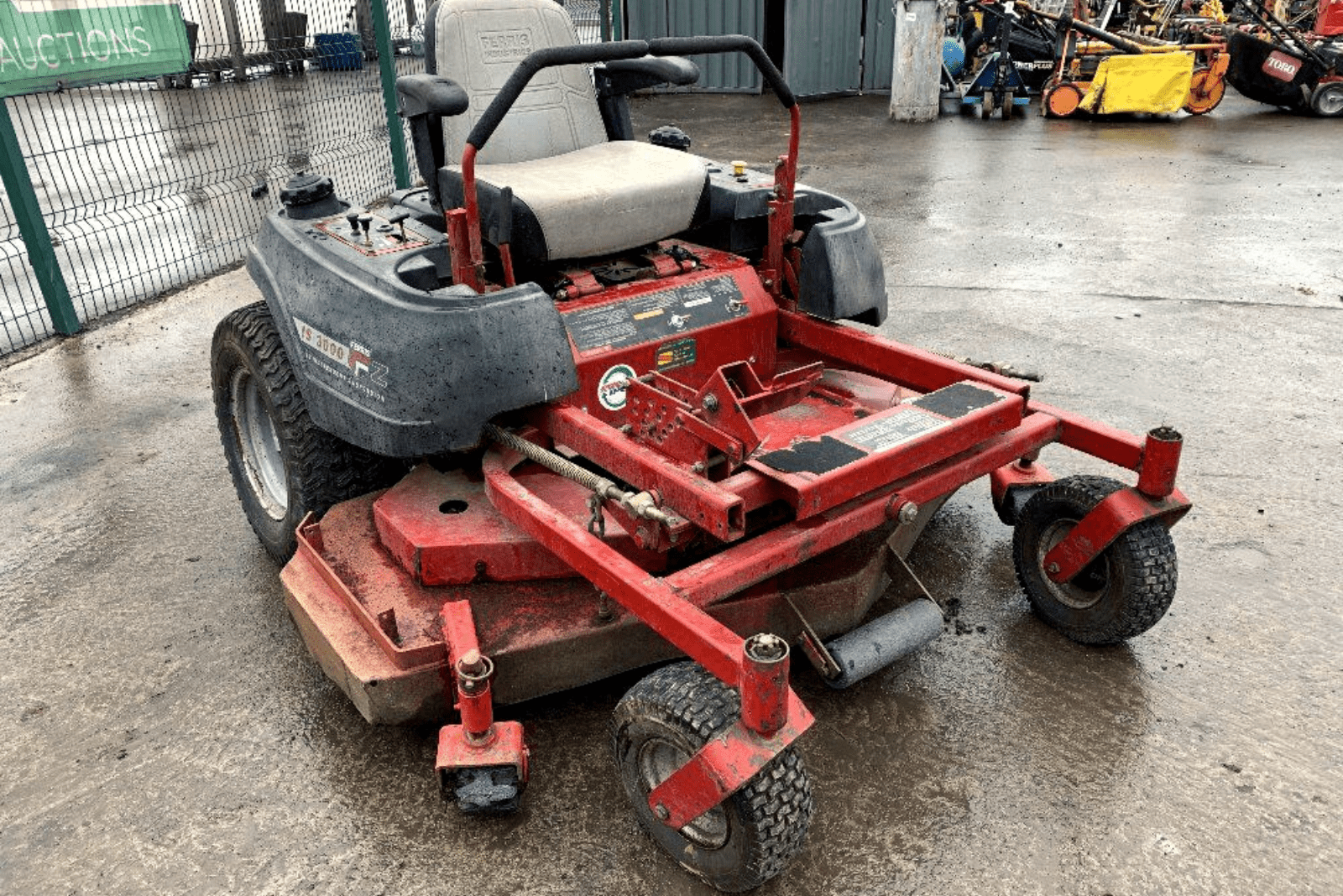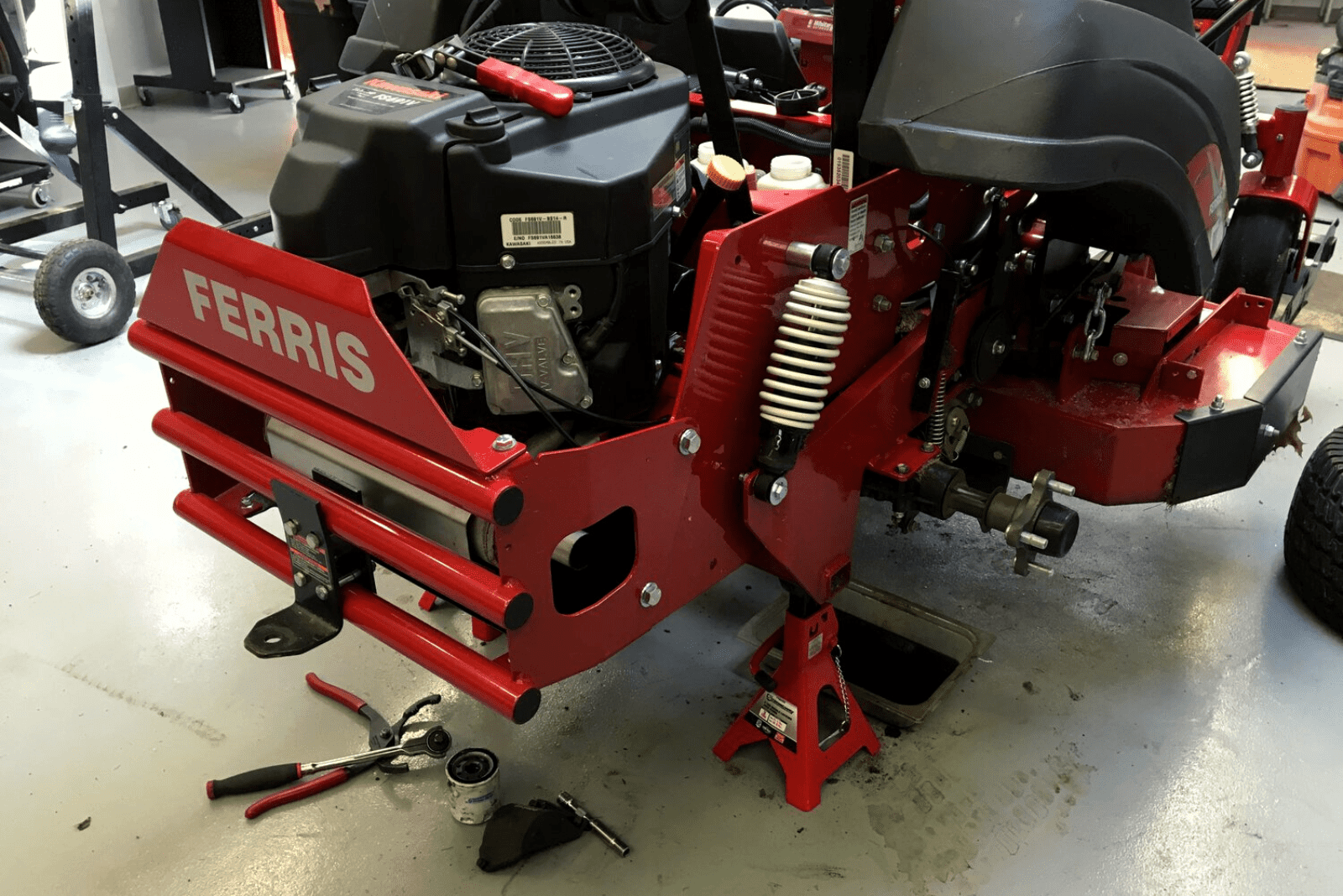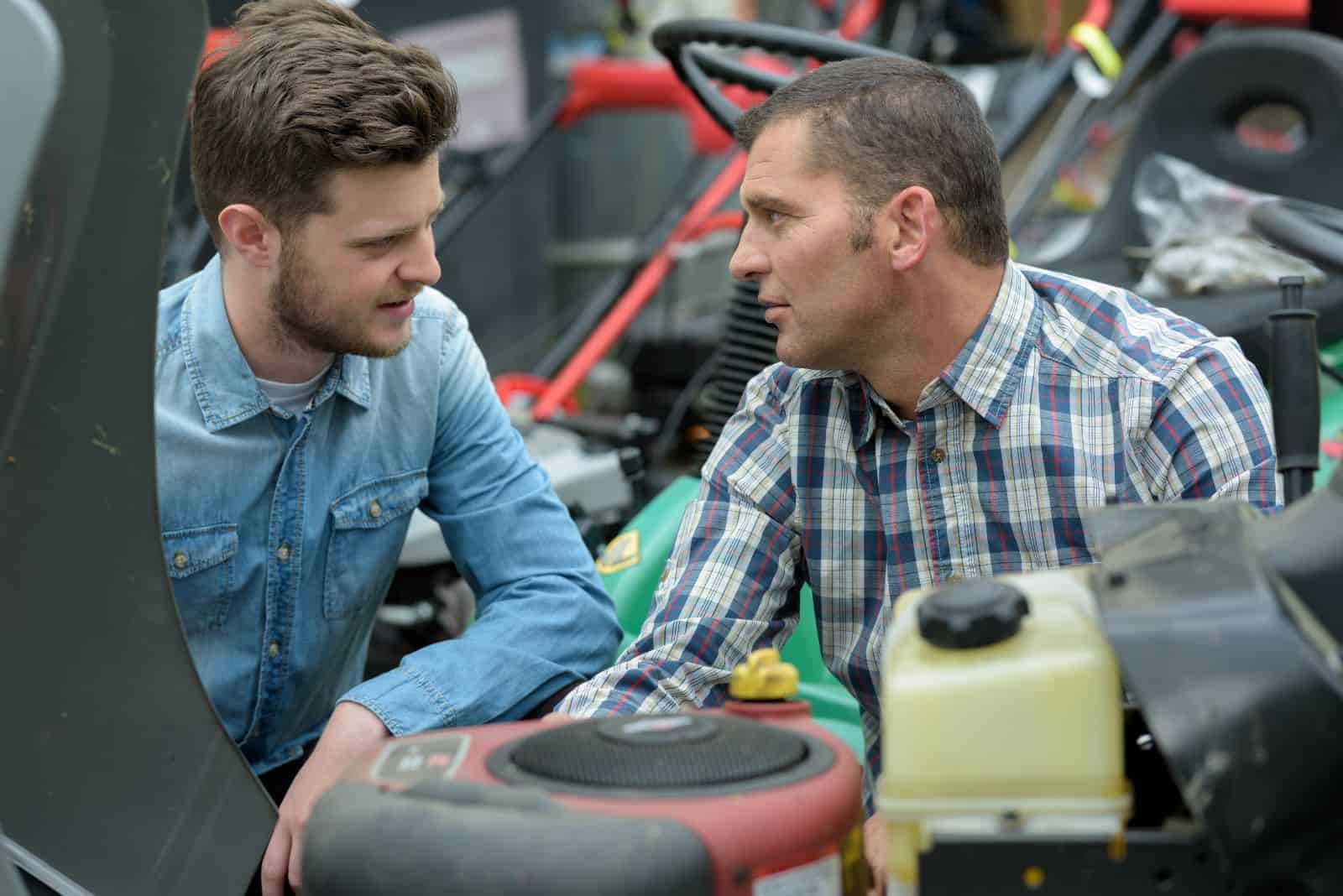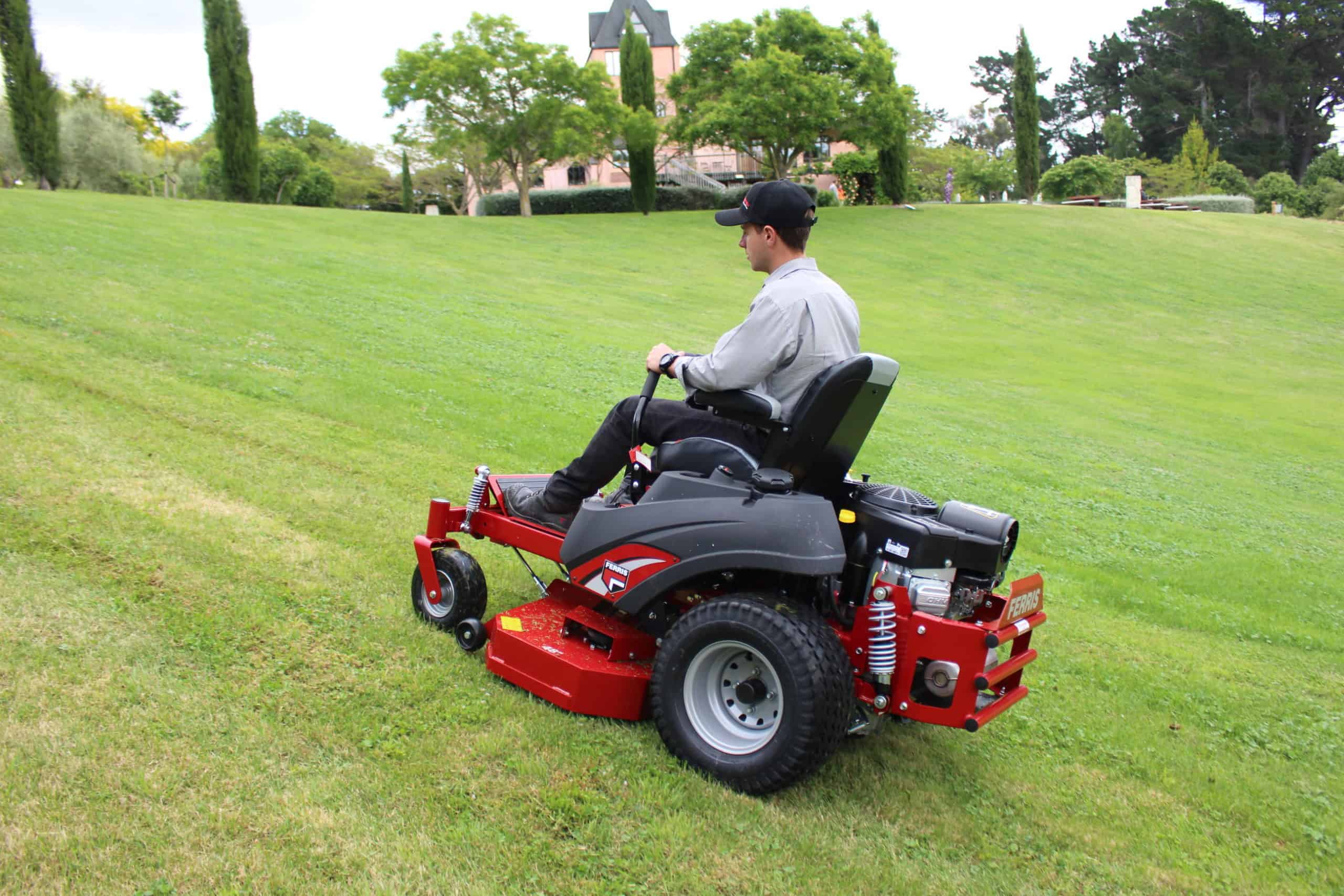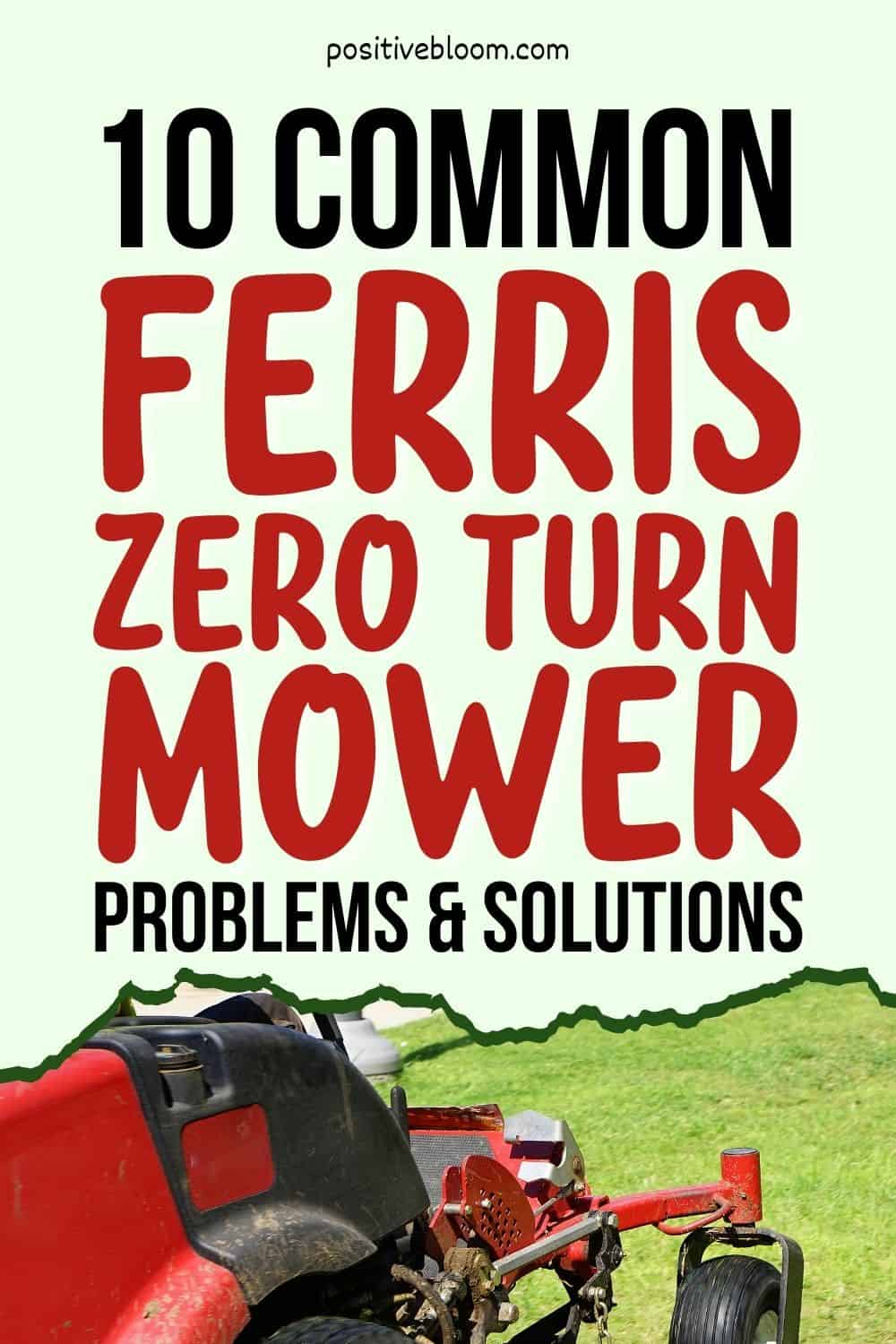We all want to speed up our mowing chores and make them as easy as possible, which is probably one of the main reasons we buy riding mowers in the first place!
It doesn’t matter whether we own a Toro , Cub cadet , or Country clipper; they can all break, make uneven cuts, and suffer from a myriad of problems.
Therefore, it’s not surprising that we experience Ferris zero turn mower problems from time to time.
The good news is that these lawn mowers can be fixed, so we thought we’d bring some troubleshooting tips and tricks for you to try.
Of course, you shouldn’t be doing anything on your mower if you have a valid warranty , but if you don’t, give these ideas a try or take it to your local lawn mower mechanic.
We’ll also include some ways of maintaining your mower so that you can reduce the chances of having to deal with serious issues.
Let’s begin!
10 Ferris Zero Turn Mower Problems And Solutions
Always read the operator’s manual before doing any work on your mower so you can get acquainted with the safety procedures and avoid possible injuries.
The key thing is diagnosing the issue and the cause. For instance, if you’re having problems starting your mower, you first need to figure out whether it is the engine, carburetor , or something else.
Unfortunately, starting issues aren’t the only problem you may encounter with this mower. Hydro-gear issues, constant vibrations, traction and tire issues, and uneven cuts are just some problems you may have to deal with.
But don’t let this discourage you; other mowers also experience some issues, and you might have John Deere or Country clipper problems to deal with!
1. Starting Problems
One of the worst things you can encounter is your mower not starting. The critical thing is to keep your cool and examine it thoroughly.
The most common causes of this malfunction are clogged air filters, poor connections and electric components, clogged fuel tanks, and defective charging systems.
The first things you should check are battery and fuel levels. If the fuel tank or battery are empty, your mower won’t be able to start. Recharge the battery and top up the tank, and if it still doesn‘t work check for other issues.
You might have to change the battery if it‘s weak and dying, but make sure you never allow it to discharge. If you won’t be using your mower for quite some time (for instance, over winter), you should take out the battery and store it in a warm place or even use a battery tender if you have one.
Remember to check the connections while you’re at it. Broken or frayed wires are dangerous and they won’t transfer enough power, just like corroded and loose connections. Don’t forget to check the spark plugs , replace all the wiring, and tighten the connections if need be.
If the fuel tank and battery are all full and working, you should check the carburetor and clean it with a carburetor cleaner. If that doesn’t work, clean it manually.
2. Engine Not Working Properly
Perhaps your mower will turn on, but it’s clear that it’s lacking power or is difficult to start. You should check whether the fuel mixture is too rich in this case. Too much fuel in the air/ fuel mixture may flood the engine.
The quality of gasoline is also important because you don’t want your engine to fail prematurely. Most mower engines are designed to work with gasoline that has 10% ethanol , and anything above that is too much.
Another thing that leads to engine issues is gas that‘s been sitting in the mower for too long. Thankfully, you can easily resolve these issues by draining the tank and filling it with fresh fuel.
However, if that doesn’t help you can adjust the throttle and clean the air filter.
Another thing that commonly causes issues with the engine are large spark plug gaps, so you should reset the gap if you discover that that’s the cause of your engine problems.
This is also a common problem in Kubota zero mowers.
3. Hydro-Gear Issues
Almost all Ferris zero turn mowers have hydrostatic transmission, so they’re bound to experience some hydro-gear issues. Sometimes the pump cannot generate pressure, and it’s most likely because there’s air in the transmission or because the pump has a low oil level (there is more air than oil).
Getting this issue fixed requires skill, so be prepared. First, take the control lever out of the neutral position and disengage the parking brake and the clutch.
Push forward the motion control levers for five seconds and then hold them in place for another five seconds.
Remove the air from the transmission and fill the pump with oil, turn off the engine, and then turn it on again. Imagine spending all that time trying to find the best weed killer for your Bermuda grass , only to have a broken mower that isn‘t able to cut a single blade!
Sometimes the hydro-gear issue isn’t easy to fix, and you can watch this video for more details and find tips and tricks for repairing your mower:
4. Constant Vibrations
So, the good news is that Kawasaki engines have fewer vibration problems than Briggs and Stratton. There’s not much between these engines, however, and you won’t be making a mistake with either of them.
If you want to do everything within your power to avoid vibration issues you should start by getting a mower with a Kawasaki engine. They are also more powerful than Briggs and Stratton .
The thing is, zero turn mowers usually have problems with vibration regardless of the brand, model, or even ground speed .
But unbearable vibration isn’t normal and is an indication that something’s not right.
There are a couple of things you can do in this case.
If your mower is brand new or in excellent condition, but still vibrates excessively, you should check the surface you’re mowing. It doesn’t have to be completely smooth, but the rough ground can make your mower vibrate more.
Some Ferris lawn mowers come with a high-quality suspension seat, which lessens the shock and may prove a necessary feature for mowing uneven surfaces.
However, the most common cause of constant vibrations are damaged, unbalanced cutting blades, and uneven weight distribution. You should angle the mower blades properly, sharpen them, or replace them if they’re beyond repair.
5. Brake Problems
Brake problems aren’t to be trifled with, and even though these riding mowers don’t usually reach speeds above 10 mph, you can still get hurt if one hits you!
The main reason brakes don’t work is because they’re not adjusted properly or the calipers are worn out.
The first thing you should do is check the calipers (these are the components found on brakes that press the brake pads against the rotors, which slows down the spinning of the wheels and reduces speed).
Brake pads do get worn out, so you need to adjust them every once in a while and check them frequently, pushing them further down when necessary.
Another reason for brake problems is debris that finds its way into the brakes, so make sure you thoroughly clean any mud, grass clippings, and twigs left after mowing.
Finally, a fluid leak can make the brake pads damp and cause them to lose their friction and ability to stop the wheel from rotating. You should tighten any loose fittings and address other possible issues causing the leak by replacing the filters, getting the air out of them, etc.
6. Traction Issues
Zero turn mowers don’t usually experience any traction issues, but they can appear after prolonged usage. Thankfully, we’ve got a couple of aces up our sleeves to help you stop spinning.
The main thing is to buy wheels with better traction , but if that doesn’t help you can look at the causes of low traction. The key things that lead to inadequate physical resistance of wheels are a damaged mower deck and blades, which have to be in excellent condition to get the best results.
Check the state of both the deck and the blades, and if the blades look sharp and in good condition, you can replace your deck.
However, sometimes a simple thing like releasing the tire pressure can be all your mower needs , so always check these smaller things before moving on to more complicated procedures.
Remember, your mower needs to be in tip-top shape in order to cut the grass types that thrive in Florida (or any other place for that matter) and provide the best lawn care possible .
7. Wheels Not Turning
We always think about riding mowers as superior to walk-behind mowers, but what if the wheels suddenly stop spinning?
There are two leading causes of this issue: worn-out drive belts and wheels.
If the drive belt is loose or worn, it will break or keep coming off and cause issues such as a slow-moving mower or the mower not moving at all.
The drive belt is located on the transaxle of the mower, which is positioned on the rear wheels as zero turn mowers operate on rear-wheel drive. Check whether the belt is on the pulleys and if it’s tight enough. If the belt is worn out, you should replace it with a new one.
If the belt doesn’t seem to be causing the problem, you should check the wheels. If they’re worn out or the gears on your wheels are worn out, you should replace either the wheels or gears.
8. Uneven Cuts
Another common problem that’s quite annoying is uneven cuts and track marks on your lawn. This can happen with any mower, whether it’s a Ferris or you’re having Spartan mower problems .
The common causes of uneven cuts are pretty obvious: worn, damaged, or dull blades, mowing with high speed, and not overlapping.
You should change the blades or sharpen them, slow down, and overlap rows to make sure you’ve gotten every grass leaf.
Adjust the cutting height according to the terrain and you’ll be enjoying your transformed lawn before you know it! However, cut quality depends on many other things, so if you notice that one side cuts lower than the other you should also check the tire pressure and ensure it’s the same in all the tires.
Sometimes the blades might not engage, and you should try replacing the PTO switch or belt to try and fix the issue in this case.
You should also clean the mower blades of all debris, grass clippings , and anything else that could obstruct them.
Finally, make sure you charge the battery before mowing or the engine might not turn on even if there is enough power.
9. Difficulties Mowing Wet Grass
This issue is a bit controversial because many claim that you can’t (or shouldn’t) mow wet grass . However, this mower is made to cut both dry and wet grass , so it’s a problem when damp grass leaves are left behind.
Sometimes the fuel mixture might be too rich or the oil levels too high , and you can address these issues at the same time because they can cause other more serious issues such as engine and hydro-gear problems.
Cleaning the air filter and adjusting the throttle may help you get that even cut even if the grass is wet, and prevent more severe issues with the engine and hydro-gear at the same time .
The difficulties in mowing wet grass are usually caused by dull blades , so that should be the first thing you check. If the blades are damaged, you’d be better off replacing them.
10. Mower Not Moving
It’s a big problem if your mower starts but won’t move because this issue cannot be resolved by simply filling the tank or recharging the battery!
A loose, worn, or broken drive belt commonly causes this problem , so you should check whether it’s properly adjusted and replace it if it’s damaged. Another common cause is when the idler spring causes too much tension to the drive belt , which is your cue to replace it.
Make sure that the hydraulic oil isn’t hot, old, or low when riding your Ferris mower. When the amount of oil is low or the quality is poor, the hydraulic fluid can overheat and lead to some serious issues.
Your mower may not be able to move if air gets inside the hydraulic system, so if you don’t want to spend hundreds of dollars on a problem that could have easily been avoided, remember to bleed the air out of the hydraulic system after changing the fluid.
Here’s a video with some amazing tips for changing the fluid on your zero turn mower :
But that’s not all! Your mower may also stop moving due to a plugged fuel filter and lines, air filter, and a dirty carburetor , so don’t forget to clean these components and replace them if you notice some damage.
Maintaining Ferris Zero Turn Mower
To extend the life of your mower, you should maintain it properly.
This includes cleaning your mower regularly, checking the oil and fuel from time to time, and being careful about how you store it.
Our detailed care guide for maintaining your Ferris zero turn mower will teach you everything you need to know.
Clean The Mower
The most important thing is to clean your mower as often as you can. Wash it from time to time – just make sure to cover all the electrical components and protect them from moisture. Allow the mower to dry and then grease all the parts that need it.
Clean the deck and engine cooling fins after using the mower for 25 hours. You can clean the spark arrestors every 50 hours and the battery cable every 100 hours. Finally, clean the undersides of the cutting deck once every 400 hours and it should be all good.
Store The Mower
It is essential to store the mower properly if you’re not using it because the sun may damage it and the rain may lead to corrosion and rust.
Keep it in a garage or any sheltered place where the weather won’t have an impact on it. Keep the mower in the shed or a garage over winter because the snow and cold temperatures can cause damage as well.
Check The Oil
Checking and replacing the engine oil , lubricating the units that need more grease, and replenishing hydro oil are all important components of maintaining your mower and prolonging its life.
Check the oil every time you use your mower, replace the engine oil every 50 hours, lubricate the mower every 25 hours, and change the hydro oil every 400 hours.
However, if you’ve just bought a new mower you should change the hydro oil after 100 hours the first time, and then keep on changing it every 400 hours.
Store The Battery
It is vital to preserve the battery to prolong its life or you’ll end up having to buy a new one every year. Therefore, you should be mindful of how you store it when not using the mower.
If you’re preparing for the winter and you know you won’t be using the mower for the next couple of months, you should disconnect the battery and store it in a warm place so that it doesn’t lose much charge.
You can also use a battery tender to prolong its life and maintain the charge so that it’s ready once the spring comes.
Check The Fuel
Finally, checking the fuel is extremely important because it can go bad when the mower isn’t used for long periods.
Thankfully, you can get a fuel stabilizer on Amazon and forget about old gasoline problems. Don’t let evaluating the differences between ryegrass and fescue and choosing the best grass for your lawn go to waste.
Frequently Asked Questions
We have examined the most common Ferris zero turn mower problems, but there are still some questions that need to be answered.
You will find plenty more interesting and useful facts about Ferris lawn mowers to help you take better care of your machine.
How many hours will a Ferris zero turn mower last?
Ferris zero turn mowers last quite some time, and you’ll usually be able to use them for 2,000 hours before having to make any significant repairs.
However, they can easily last up to 5,000 or even 7,000 hours if you check them regularly, clean the filters, and maintain them properly.
What is the average price of a Ferris zero turn mower?
The average price of a new Ferris zero turn mower is around $10,000. However, there are some cheaper models that range between $6,000-7,000.
What type of gasoline does a Ferris zero turn mower use?
Ferris zero turn mowers can run on diesel, propane, or gasoline depending on the model.
Diesel and gas are easier to find than propane, but Ferris still gives you an option if you want to go green.
Diesel lawn mowers last longer, while gasoline zero turn mowers have a lower up-front cost.
It’s up to you to decide which one suits you best!
Conclusion
This article went through ten different Ferris zero turn mower problems and their solutions, so you no longer have to wonder what’s wrong with your mower or how to fix it.
The most common problems include your mower not starting or moving, the engine not working properly, uneven cuts, etc.
Now you know what to look out for and recognize the problem when it occurs, so you should be able to extend the life of your mower by several years.
We also included some maintenance tips so you can postpone those issues as long as possible.
Good luck with your mower, and until next time!
Like this post? Share or pin it for later!

